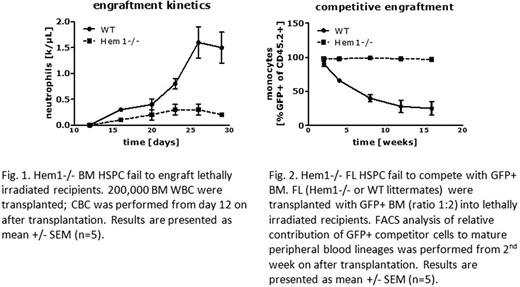Abstract
Background
Spatiotemporally controlled actin dynamics are crucial for a vast number of cellular functions including migration, proliferation, attachment or immunological synapse formation. Environmental signals activate cognate surface receptors which in turn engage specific small GTPases. Signal integrators (e.g. WASP, WAVE complex or WIP) propagate the signal to Arp2/3 complex and lead to immediate actin polymerization. Here we show that disruption of one of the actin polymerization pathways through specific targeting of WAVE complex disturbs hematopoietic stem and progenitor cells (HSPC) bone marrow retention and their sequential differentiation towards mature blood cells.
Methods
We made use of the recently described mouse model of Hem1 ablation. Hem1 is a strictly hematopoietic specific component of WAVE complex; its loss disrupts the entire WAVE complex exclusively in cells of hematopoietic origin. An array of in vitro assays was employed to test cell intrinsic effects of Hem1 ablation on actin polymerization dependent cellular functions. In vivo transplantation experiments were performed to study the impact of Hem1 ablation on immature and in consequence on mature hematopoiesis.
Results
Hem1-/- HSPC display a bone marrow (BM) retention defect evidenced by strongly elevated numbers of circulating HSPC and 50% reduced BM cellularity. In line with that, migration towards CXCL12, a key BM anchor for HSPC, was completely abrogated in Hem1-/- HSPC. Attachment to feeder cells was also decreased by 35% compared to WT HSPC, although stress fiber formation upon CXCL12 stimulation or general ability to polarize was not affected. Next we tested whether this cellular phenotype had any impact on HSPC performance in vivo. Homing, the initial interaction of transplanted HSPC with BM environment, was not affected by Hem1 ablation, while engraftment, the ability to repopulate all mature hematopoietic lineages, was strongly diminished. Platelet and RBC engraftment was delayed, whereas Hem1-/- neutrophils did not engraft at all (Figure 1). Hem1-/- mice presented with chronic inflammation, hyperleukocytosis and elevated pro-inflammatory cytokine plasma levels. To rule out inflammation as causal for numeric and functional Hem1-/- HSPC depletion we performed co-transplantation experiments. Hem1-/- or WT BM was transplanted in a four-fold excess over GFP+ competitor BM. In Hem1-/- transplanted recipients, already 4 weeks after transplantation 60 to 90% of both myeloid and lymphoid compartments were GFP+, whereas, as expected, in the control experiment WT BM out-competed GFP+ BM over time. A similar picture emerged in secondary recipients. Again Hem1-/- BM completely lost against, whereas WT BM prevailed over GFP+ competitor. We furthermore confirmed that the Hem1-/- HSPC cell intrinsic defect is already apparent during embryonic development: As in BM of adult Hem1-/- mice, HSPC content in E14.5 old fetal livers (FL) was reduced by half compared to WT littermates. Also the competitiveness of FL HSPC was strongly impaired, similar to Hem1-/- adult BM HSPC. Whereas short term engraftment was provided by more mature competitor GFP+ BM in both recipients groups, already 4 weeks after transplantation, as expected, WT FL derived HSPC took over blood cell production and completely outcompeted GFP+ BM. In Hem1-/- FL recipients, by contrast, the contribution of competitor GFP+ BM to hematopoiesis remained high for the whole period tested without significant contribution of Hem1-/- FL hematopoiesis (Figure 2). Taken together, Hem1 (and, by extension, WAVE complex) governs HSPC BM retention and proper engraftment.
No relevant conflicts of interest to declare.
Author notes
Asterisk with author names denotes non-ASH members.


This feature is available to Subscribers Only
Sign In or Create an Account Close Modal